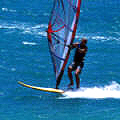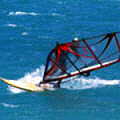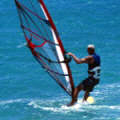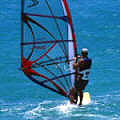Haas Tack
The Hass-Tack is a flashy transition that integrates a variety of technical skills such as switch stance riding, backwinding, and clew first sailing. When mastered this move is a flowing and artistic maneuver showing graceful sail and board control. Invented by Hass Jahrmarkt of Tangier, Morocco while experimenting with a variation of the Duck-Tack. Tricky to learn but most useful in moderate to light winds with eventual mastery to high wind.







Rider: Royn Bartholdi
Steps
 1)
Unhook, get both feet out of the straps and head downwind to a broad reach. This allows you to setup the move by stabilizing the board and reducing the apparent wind, making the move easier. Switch stance with a hop and completely sheet out with the sail so there is little power in the sail. Remember to broaden your hand grip on the boom by moving just your back hand farther back toward the clew. Start carving the board into the wind by applying pressure to the windward rail and lean the mast into the wind. This is continuous movement.
1)
Unhook, get both feet out of the straps and head downwind to a broad reach. This allows you to setup the move by stabilizing the board and reducing the apparent wind, making the move easier. Switch stance with a hop and completely sheet out with the sail so there is little power in the sail. Remember to broaden your hand grip on the boom by moving just your back hand farther back toward the clew. Start carving the board into the wind by applying pressure to the windward rail and lean the mast into the wind. This is continuous movement.  2)
Slice the sail into a backwind position. Notice the forward foot remains in back of the mast to allow the board to round up quicker into the wind. This will feel like the energy of the move is being wound up. Your eyes are focused on the top of the sail, if not above the sail.
2)
Slice the sail into a backwind position. Notice the forward foot remains in back of the mast to allow the board to round up quicker into the wind. This will feel like the energy of the move is being wound up. Your eyes are focused on the top of the sail, if not above the sail.  3)
Immediately place the forward foot in front of the mast. Keep pushing out with the clew while letting the mast move to the tail of the board. This will allow the nose of the board to continue its journey to the eye of the wind while keeping your body balanced and positioned over the mast base. The clew will become the leading edge of the backwind with your clew-arm straight and rigid. You control the sail with the clew-arm.
3)
Immediately place the forward foot in front of the mast. Keep pushing out with the clew while letting the mast move to the tail of the board. This will allow the nose of the board to continue its journey to the eye of the wind while keeping your body balanced and positioned over the mast base. The clew will become the leading edge of the backwind with your clew-arm straight and rigid. You control the sail with the clew-arm.  4)
After you have carved into the eye of the wind then let the mast become vertical by pushing with the clew hand and easing the pressure on the mast hand. You are letting the wind stand you upright here and the energy of the move feels like you are being unwound. The board will now be on the other tack.
4)
After you have carved into the eye of the wind then let the mast become vertical by pushing with the clew hand and easing the pressure on the mast hand. You are letting the wind stand you upright here and the energy of the move feels like you are being unwound. The board will now be on the other tack.  5)
Push the clew thru the eye of the wind and pull the mast toward your chin as the sail fills with wind power to a normal clew-first sail position. Pressure your front foot until the board is sufficiently pointing in the direction you want and you are balanced and in control.
5)
Push the clew thru the eye of the wind and pull the mast toward your chin as the sail fills with wind power to a normal clew-first sail position. Pressure your front foot until the board is sufficiently pointing in the direction you want and you are balanced and in control.  6)
Finish by pushing out the clew hand and flipping the rig.
6)
Finish by pushing out the clew hand and flipping the rig.  7)
Reel in the sail, adjust hands and sail away. Congratulations trick meister!
7)
Reel in the sail, adjust hands and sail away. Congratulations trick meister! Videos
Loading the player ...
This is a one handed variation of the Haas Tack. You will notice that once I am backwinded and the clew hand is windward (the leading edge into the wind), then I can remove the windward hand from the boom (I raise the hand in the air) because all the control is with the clew hand until I am on the other reach and need power in the sail again.
Tips
- Practice sailing across the water in the switch stance feet position to gain confidence in this sailing style.
- Practice backwinded sailing because this skill is valuable for maintaining control of the sail during the backwinded portion of the maneuver.
- While sailing in light winds you can head upwind instead of downwind. The stronger the winds the more you will need to bear off-wind to keep from being blown onto your back during the backwinded section on the maneuver.
- While sailing in light winds you can also step directly to the front of the mast and backwind the sail in one movement however I advise to keep the feet behind the mast until the end of the maneuver.
- The carving version actually makes a hook like pattern in the water when viewed from above.
Ideas
- Try a Clew-First-Hass-Tack.
- Try a Switch-Stance-Hass-Tack.
All Contents Copyright © 2008-2025 Royn Bartholdi. All Rights Reserved